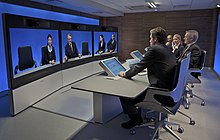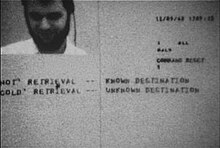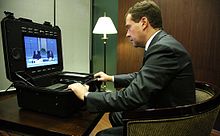deoconferencing (VC) is the conduct of a videoconference(also known as a video conference orvideoteleconference) by a set oftelecommunication technologies which allow two or more locations to communicate by simultaneous two-way video and audio transmissions. It has also been called 'visual collaboration' and is a type of groupware.


Videoconferencing differs fromvideophone calls in that it's designed to serve a conference or multiple locations rather than individuals. It is an intermediate form of videotelephony, first used commercially in Germany during the late-1930s and later in the United States during the early 1970s as part of AT&T's development ofPicturephone technology.
With the introduction of relatively low cost, high capacity broadbandtelecommunication services in the late 1990s, coupled with powerful computing processors and video compression techniques, videoconferencing has made significant inroads in business, education, medicine and media.
History

Videoconferencing uses audio and video telecommunications to bring people at different sites together. This can be as simple as a conversation between people in private offices (point-to-point) or involve several (multipoint) sites in large rooms at multiple locations. Besides the audio and visual transmission of meeting activities, allied videoconferencing technologies can be used to share documents and display information on whiteboards.
Simple analog videophonecommunication could be established as early as the invention of the television. Such an antecedent usually consisted of two closed-circuit television systems connected via coax cable or radio. An example of that was the German Reich Postzentralamt (post office) video telephone network serving Berlin and several German cities via coaxial cables between 1936 and 1940.
During the first manned space flights,NASA used two radio-frequency (UHF orVHF) video links, one in each direction. TV channels routinely use this type of videotelephony when reporting from distant locations. The news media were to become regular users of mobile links to satellites using specially equipped trucks, and much later via special satellite videophones in a briefcase.
This technique was very expensive, though, and could not be used for applications such as telemedicine,distance education, and business meetings. Attempts at using normaltelephony networks to transmit slow-scan video, such as the first systems developed by AT&T Corporation, first researched in the 1950s, failed mostly due to the poor picture quality and the lack of efficient video compressiontechniques. The greater 1 MHzbandwidth and 6 Mbit/s bit rate of thePicturephone in the 1970s also did not achieve commercial success, mostly due to its high cost, but also due to a lack of network effect —with only a few hundred Picturephones in the world, users had extremely few contacts they could actually call to, andinteroperability with other videophone systems would not exist for decades.
It was only in the 1980s that digital telephony transmission networks became possible, such as with ISDNnetworks, assuring a minimum bit rate(usually 128 kilobits/s) for compressed video and audio transmission. During this time, there was also research into other forms of digital video and audio communication. Many of these technologies, such as the Media space, are not as widely used today as videoconferencing but were still an important area of research. The first dedicated systems started to appear in the market as ISDN networks were expanding throughout the world. One of the first commercial videoconferencing systems sold to companies came fromPictureTel Corp., which had an Initial Public Offering in November, 1984.
In 1984 Concept Communication in the United States replaced the then-100 pound, US$100,000 computers necessary for teleconferencing, with a $12,000 circuit board that doubled the video frame rate from 15 up to 30 frames per second, and which reduced the equipment to the size of a circuit board fitting into standard personal computers. The company also secured a patent for a codec for full-motion videoconferencing, first demonstrated at AT&T Bell Labs in 1986.

Videoconferencing systems throughout the 1990s rapidly evolved from very expensive proprietary equipment, software and network requirements to a standards-based technology readily available to the general public at a reasonable cost.
Finally, in the 1990s, Internet Protocol-based videoconferencing became possible, and more efficient video compression technologies were developed, permitting desktop, or personal computer (PC)-based videoconferencing. In 1992 CU-SeeMewas developed at Cornell by Tim Dorcey et al. In 1995 the first public videoconference between North America and Africa took place, linking a technofair in San Francisco with a techno-rave and cyberdeli in Cape Town. At the Winter Olympics opening ceremony in Nagano, Japan, Seiji Ozawaconducted the Ode to Joy fromBeethoven's Ninth Symphonysimultaneously across five continents in near-real time.
While videoconferencing technology was initially used primarily within internal corporate communication networks, one of the first community service usages of the technology started in 1992 through a unique partnership with PictureTel and IBM Corporations which at the time were promoting a jointly developed desktop based videoconferencing product known as the PCS/1. Over the next 15 years,Project DIANE (Diversified Information and Assistance Network) grew to utilize a variety of videoconferencing platforms to create a multi-state cooperative public service and distance education network consisting of several hundred schools, neighborhood centers, libraries, science museums, zoos and parks, public assistance centers, and other community oriented organizations.
In the 2000s, videotelephony was popularized via free Internet services such as Skype and iChat, web plugins and on-line telecommunication programs that promoted low cost, albeit lower-quality, videoconferencing to virtually every location with an Internet connection.

In May 2005, the first high definitionvideo conferencing systems, produced by LifeSize Communications, were displayed at the Interop trade show inLas Vegas, Nevada, able to provide video at 30 frames per second with a 1280 by 720 display resolution.Polycom introduced its first high definition video conferencing system to the market in 2006. As of the 2010s, high definition resolution for videoconferencing became a popular feature, with most major suppliers in the videoconferencing market offering it.
Technological developments by videoconferencing developers in the 2010s have extended the capabilities of video conferencing systems beyond the boardroom for use with hand-held mobile devices that combine the use of video, audio and on-screen drawing capabilities broadcasting in real-time over secure networks, independent of location. Mobile collaboration systems now allow multiple people in previously unreachable locations, such as workers on an off-shore oil rig, the ability to view and discuss issues with colleagues thousands of miles away. Traditional videoconferencing system manufacturers have begun providing mobile applications as well, such as those that allow for live and still image streaming.

 پریسا خانم
پریسا خانم